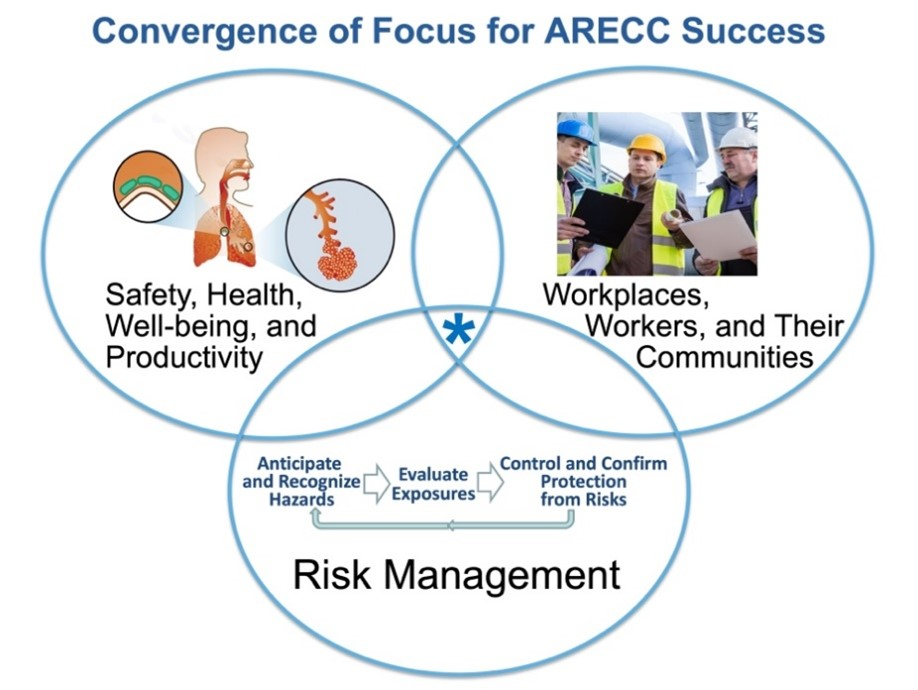ARECC: Getting the Right Things Done Right Every Day
In our myriad occupational settings, more than one solution can exist for any given problem. Our two overarching considerations are to take a managerial frame of mind and to allocate our limited resources wisely. Rigorous prioritization is required to address the greatest risks and do the most good.
As OEHS professionals, the five principles of our ARECC decision-making framework provide an evidence-based, risk-informed process to anticipate and recognize hazards, evaluate exposures, implement control measures, and confirm protection from risks. (This visualization of ARECC, available from the AIHA website, will open in a new tab in your browser.) As defined in decision science, the term "decision-making framework" refers to a configuration of principles, processes, and practices to proceed from information and objectives to decisions that inform actions and achieve outcomes.
ARECC began as "recognize, evaluate, and control" and evolved over many decades. In 1994, then-AIHA president Harry Ettinger added the "anticipate" step to proactively apply the growing IH body of knowledge and experience in assessing and managing hazards, exposures, and resulting risks in both existing and emerging situations. In 2011, the "confirm" step was added to shift the focus from simply controlling hazards to confirming protection from risks. The addition of "confirm" ensures that all aspects of the decision-making framework are effectively carried out and that the desired outcomes are achieved.
The risk assessment portion of ARECC synthesizes information from three highly interlinked inputs about hazards, exposures, and exposed populations:
- exposure- and population-informed hazard assessment, where the dose-response relationships and associated hazard criteria (including occupational exposure limits, skin notations, sensitization notations, and hazard/exposure bands) are identified and defined for the population of potentially exposed individuals
- hazard- and population-informed exposure assessment, where the relevant and reliable exposure and population information is collected for assessment against and refinement of the hazard criteria
- hazard- and exposure-informed population assessment, where the relevant and reliable susceptibility information for the exposed population is collected for assessment against and refinement of the hazard criteria (explicit attention to population assessment is conveyed in the recently released AIHA "Competency Framework: Understanding and Applying ARECC to Occupational and Environmental Health and Safety" and in the newly released AIHA "Technical Framework: Susceptible Worker Protection")
The aggregation and evaluation of the risk assessment information enables the characterization of risk for realistic combinations of hazards, exposures, and population susceptibilities. That assessment of risk is then used to inform the risk management process, whereby leadership commitment, use of Prevention through Design, appropriate application of the hierarchy of controls, and proactive steps to confirm compliance and protection can effectively be applied to meet established risk tolerances.
While the process focuses on recognized hazards, exposures, and risks, the practice of ARECC also facilitates the identification and management of emerging, unrecognized, or unidentified hazards and their respective risks. The AIHA bodies of knowledge (BoKs) and the AIHA frameworks identify essential resources for achieving proficiency in occupational hygiene competencies. The AIHA BoKs can be used in conjunction with Total Worker Health, Total Exposure Health, Prevention through Design, Right Sensors Used Right, and industrial hygiene 4.0. Together, these efforts integrate occupational safety and health protection with workplace policies, programs, and practices that promote health and prevent disease to advance the safety, health, well-being, and productivity of all workers and their communities.
An ever-present challenge for our OEHS community is to consistently engage all stakeholders, including many individuals and organizations who may not understand how their expertise can contribute to the successful application of ARECC. And although we are making progress, many individuals and organizations may still be reluctant to get on board. Building and sustaining a culture of safety, health, well-being, and productivity requires the following steps:
- engage the community
- inform the interested
- reward the responsive
- understand and incentivize the reluctant
Success requires a convergence of focus at the nexus of safety, health, well-being, and productivity; management of risks; and the technical details of workplaces, workers, and their communities (see Figure 1).

Our pathway to achieve the ARECC objective to protect workers and their communities requires the following:
- We must make it easier for everyone to get the right things done right.
- Workers and their communities need to be connected, protected, and respected.
- Workers and their communities must have leaders, cultures, and systems with all the tools, training, and experience needed to achieve safety, health, well-being, and productivity.
- Attention to risks must be paid in all the places we live, learn, work, and play.
We invite feedback and discussion, and we look forward to engaging with you through Catalyst, through your AIHA volunteer and leadership colleagues, or directly through the emails provided below.
Readers are encouraged to share their feedback with Mark D. Hoover, Kent A. Candee, Matthew M. Dahm, Linh Phan, Jennifer Sahmel, and Spencer Pizzani.
Resource
AIHA: "Competency Framework: Understanding and Applying ARECC to Occupational and Environmental Health and Safety" (2022).

Comments
There are no submissions.